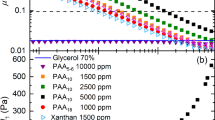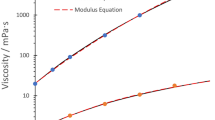Abstract
WE report here a new approach to studying the shear behaviour of thin films of oil under conditions of elastohydrodynamic lubrication such as arise at points of contact in ball bearings or between gear teeth. During its passage through the contact the oil is rapidly compressed to pressures in the region of 104 bar and then sheared by the sliding motion of the metal surfaces. Hitherto this behaviour has been studied using rolling contact disk machines in which rollers having parallel axes are pressed into contact. Rolling motion generates an oil film of known thickness (∼1 µm) between the hard steel surfaces; superimposed sliding shears the film. At very small sliding speeds—shear rates—the behaviour is linear: the mean shear stress required to shear the film τ̄ is proportional to the sliding speed. At higher sliding speeds the mean shear stress reaches a maximum (critical) value τ̄c1. It has been suggested2 that the observed behaviour can be explained by the oil exhibiting viscoelastic properties at these high pressures, when the viscosity is known to increase by many orders of magnitude. Unfortunately this hypothesis cannot be tested with certainty by conventional disk machine tests, which do not distinguish unequivocally between viscous and elastic response of the fluid in the contact zone. We report here a different rolling contact experiment which reveals viscoelastic behaviour directly by separating elastic and viscous response of an oil film under elastohydrodynamic conditions.
This is a preview of subscription content, access via your institution
Access options
Subscribe to this journal
Receive 51 print issues and online access
$199.00 per year
only $3.90 per issue
Buy this article
- Purchase on Springer Link
- Instant access to full article PDF
Prices may be subject to local taxes which are calculated during checkout
Similar content being viewed by others
References
Johnson, K. L., and Cameron, R., Proc. Inst. Mech. Eng., 182, 281 (1967–8).
Dyson, A., Phil. Trans. Roy. Soc., A, 266, 1 (1970).
Poon, S. Y., and Haines, D. J., Proc. Inst. Mech. Eng., 181, 363 (1966–7).
Barlow, A. J., Harrison, G., Irving, J. B., Kin, M. G., Lamb, J., and Pursley, W. C., Proc. Roy. Soc., A, 327, 403 (1972).
Hulton, J. F., and Phillips, M. C., Nature (in the press).
Argon, A. S., Fourth IUPAC Microsymp. Macromols., Prague, Czechoslovakia (1969).
Author information
Authors and Affiliations
Rights and permissions
About this article
Cite this article
JOHNSON, K., ROBERTS, A. Rheology of Oil Films at High Contact Pressures. Nature 240, 553–554 (1972). https://doi.org/10.1038/240553a0
Issue Date:
DOI: https://doi.org/10.1038/240553a0
Comments
By submitting a comment you agree to abide by our Terms and Community Guidelines. If you find something abusive or that does not comply with our terms or guidelines please flag it as inappropriate.



